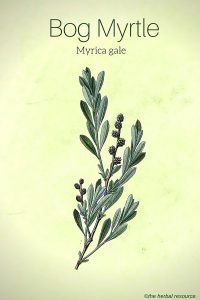The leaves of Bog Myrtle contain an essential oil which is rich in various terpenes. The main substances are alpha-pinene, 1,8 cineol, myrcene, and limonene. Additional substances found in the plant are beta-cadin-4-En-10-ol, 11-selina-4-ol, beta-terpinene, p-cymene, caryophyllene, 4.11-selinadien, beta-elemennon, germacrone and a trace amount of other substances.
The plant also contains toxic flavon-glycosides and large amounts of bitter tannins.
In Northern Europe, the bog myrtle was well-known both for its culinary and medicinal purposes for centuries. Today its uses as a medicinal herb have been mostly forgotten.
Bayberry (Myrica cerifera), native to North America and closely related to bog myrtle, is better known and is used more in modern herbal medicine.
The plant was once used as an ingredient to add flavor to beer (known as gruit) but has been replaced by hops, mainly because the bog myrtle had a reputation for causing severe headaches.
Among the Vikings, in Scandinavia, this beer was known as “porsøl”. Some believe that this brew was the reason for the Berserkers. The leaves and fruits are still used for flavoring some brands of schnapps and liqueurs.
Bog myrtle is strongly aromatic and in the past, it was used to repel fleas and other vermin. In Scotland, it is well known as a way to ward off the Highland midge. The herb’s insect repelling properties have since then been scientifically proven to be accurate.
The plant has been used, and still is, as a mosquito repellent. The essential oil is now recognized as an effective agent against insects (especially mosquitoes). In a Scottish study, volunteers allowed mosquitos free access to their arms. Only one arm was covered with a gel with bog myrtle essential oil. After 10 minutes the protected arm had average of 1.6 stings, while the unprotected arm had 9.4 average stings.
Bog myrtle is astringent and antiseptic herb with styptic, wound-healing and diuretic properties.
Traditionally it was used as a medicinal herb to treat wounds, acne and digestion problems. In Sweden, the dried bark was used to treat intestinal worms and to relieve itching.
In the past, the plant was used to dye wool yellow. It has a spicy scent, reminiscent of camphor, and a bitter strong flavor.
The fresh or dried leaves can be used to make tea. Both leaves and fruits can be, in small amounts, used to add flavor to soups, stews and some meat dishes.
The plant is one of the traditional components for Scottish wedding bouquets and is used as an ingredient in many perfume products and also as a condiment.

I learned alot from this website. Thank you so much.